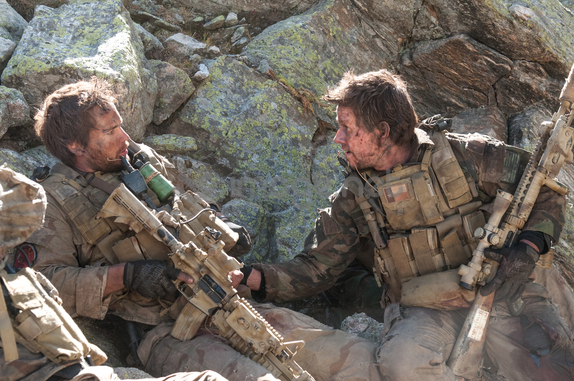
Not since Snakes on a Plane has there been a film with such a spoiler alert built into its title. (But how many of the men make it out alive???)
Yes,
only one soldier lives to tell this true tale of an Afghanistan mission
gone horribly awry. And, as is often the case with the films by Peter
Berg (Friday Night Lights, The Kingdom), the film’s politics are all over the map.
It
starts with some actual footage of Navy SEAL “Hell week,” including the
shameful bell that is rung when a young recruit can’t take any more of
the physical and emotional punishment. I thought these opening images
displayed some compassion for the sad-faced young men who cried uncle.
But as the fictionalized part of our story begins, it becomes clear that
Berg was more interested in how strong, how stalwart, how mentally
tough the SEALs who made the cut were. He idolizes the band of brothers
they become.
These early scenes, on a base camp in Afghanistan,
seem to hum with the rhythms of daily life—the gentle hazing, the
physical one-upmanship, the good natured grief-giving. When four SEALs
are assigned to bring back a Taliban warlord, it seems relatively
routine. (One wide-eyed newbie is jealous that he can’t come.)
The
four SEALs don’t have particularly distinct personalities, I’m sorry to
say. Taylor Kitsch plays the alpha male—level-headed and decent and
strong. Emile Hirsch is the squirt of the group, slightly hen-pecked by
his wife (he finds himself sifting though decorator’s paint samples, at
her behest). Ben Foster is the steeliest one, the most willing to do
what it takes. As for our leading man Mark Wahlberg? He doesn’t seem to
have much of a personality beyond: good guy.
But almost as soon as
they arrive, something goes wrong: They stumble across a shepherd and
his son. If they kill the shepherd, they won’t be able to live with
themselves, but if they let him free, what’s to stop him from alerting
the Taliban of their whereabouts? They do the right thing, morally, and
perhaps the wrong thing, strategically, and let him go.
In short order, they are surrounded.
Here’s where the film will either lose you or grab hold of you for good: Most of Lone Survivor
is that battle in the craggy mountains of Afghanistan. It’s very long,
it’s very technical, it’s very bloody. I give Berg credit for mimesis—at
least it sure looked authentic to me. But I simply didn’t want to watch
this bloody and sickening fight go on and on. What’s more, it seemed
sensationalized, yet another way for Berg to underscore the superhuman
toughness of these SEALs (literally riddled with bullets, they still
manage to engage in close combat and protect each other).
On the
one hand, Berg is showing us the hell of war, especially war in a
convoluted political backdrop like Afghanistan, where it’s hard to
distinguish between the civilians and the combatants. On the other, the
film is undeniably gung ho (even with all that blood and death it could
still be shown as part of a Navy SEAL recruitment package). And then
Wahlberg’s Marcus Luttrell is saved by a kindly Afghan villager who
loves Americans and what they’ve done for his country. Alrighty then.
Lone Survivor
is a well crafted piece of filmmaking—taut and swift, with close
attention to the kind of details that bring a world to life. But any war
film they could easily make a video game out of is no war film for me.
